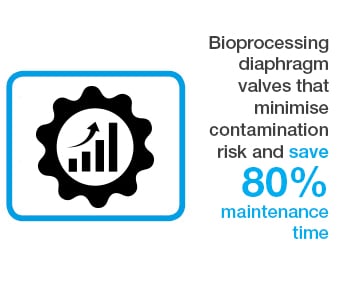- ASEPCO
Diaphragm valves
High purity Weirless Radial diaphragm valves for aseptic processing
High purity Weirless Radial diaphragm valves for aseptic processing
For over 30 years ASEPCO® have been developing the highest quality diaphragm valves for aseptic processing.
We are trusted by bioprocessing engineers worldwide for developing stainless steel valve products that deliver cost savings, accelerate process and maintenance times—while reducing the risk of contamination.
Today we manufacture the aseptic processing industry’s diaphragm valve of choice.

The diaphragm seal moves independently of the shoulder seal (the seal between the inside and outside of the valve). Using a manual or pneumatic actuator, you can easily open and close the seal. The cylindrical shape of the diaphragm, when squeezed into the sealing position, holds the seal—tested to an internal water pressure of up to 20 bar (varies depending on diaphragm material and actuator type) without leakage.
When the valve is closed, the unique CIP/SIP “behind-the-seat flow path” can be created if you add a CIP or SIP port. This flow path makes it easy to steam or clean the valve while the valve is closed. This allows for validated aseptic and sterile system connections and transfers to be performed. Combined these features save time and money by reducing maintenance time, improving performance with a less restrictive flow path.
The design of the basic weir-style diaphragm valve seal presents a number of issues for process engineers working in the biotechnology and pharmaceutical industry.
In typical configurations, a weir in the valve body rises in a fluid path and when the valve is closed, the diaphragm meets the weir to shut off the flow.
While a simple technology intended to reduce turbulence and shear, weir-style valves present a number of issues, for example in upstream processing applications they can be difficult to install, prone to leaks, and increase the potential of product contamination.
In traditional weir valves, a seal is made by placing a diaphragm between the mating faces of the valve body and actuator. This assembly is then held together with a set of nuts and bolts. The valve bodies are made from stainless steel due to its outstanding chemical compatibility outstanding corrosion resistance when exposed to repeated clean-in-place (CIP) and steam-in-place (SIP) cycles.
Biotech
ASEPCO diaphragm valves in the biotech and pharmaceutical industry
OEM
ASEPCO diaphragm valves for OEM manufacturers
To order a product or ask a question call +44 1326 370 362 or

